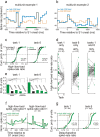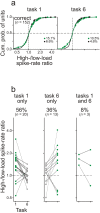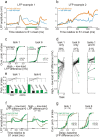Persistent neural activity in auditory cortex is related to auditory working memory in humans and nonhuman primates
- PMID: 27438411
- PMCID: PMC4974052
- DOI: 10.7554/eLife.15441
Persistent neural activity in auditory cortex is related to auditory working memory in humans and nonhuman primates
Abstract
Working memory is the cognitive capacity of short-term storage of information for goal-directed behaviors. Where and how this capacity is implemented in the brain are unresolved questions. We show that auditory cortex stores information by persistent changes of neural activity. We separated activity related to working memory from activity related to other mental processes by having humans and monkeys perform different tasks with varying working memory demands on the same sound sequences. Working memory was reflected in the spiking activity of individual neurons in auditory cortex and in the activity of neuronal populations, that is, in local field potentials and magnetic fields. Our results provide direct support for the idea that temporary storage of information recruits the same brain areas that also process the information. Because similar activity was observed in the two species, the cellular bases of some auditory working memory processes in humans can be studied in monkeys.
Keywords: Longtail macaque; auditory cortex; human; neuroscience; persistent neuronal activity; working memory.
Conflict of interest statement
The authors declare that no competing interests exist.
Figures













Similar articles
-
Neuronal activity in primate prefrontal cortex related to goal-directed behavior during auditory working memory tasks.Brain Res. 2016 Jun 1;1640(Pt B):314-27. doi: 10.1016/j.brainres.2016.02.010. Epub 2016 Feb 10. Brain Res. 2016. PMID: 26874071
-
The causal role of auditory cortex in auditory working memory.Elife. 2021 Apr 29;10:e64457. doi: 10.7554/eLife.64457. Elife. 2021. PMID: 33913809 Free PMC article.
-
Processing of auditory and visual location information in the monkey prefrontal cortex.Exp Brain Res. 2007 Jul;180(3):469-79. doi: 10.1007/s00221-007-0873-8. Epub 2007 Mar 28. Exp Brain Res. 2007. PMID: 17390128
-
Auditory short-term memory in the primate auditory cortex.Brain Res. 2016 Jun 1;1640(Pt B):264-77. doi: 10.1016/j.brainres.2015.10.048. Epub 2015 Nov 2. Brain Res. 2016. PMID: 26541581 Free PMC article. Review.
-
Domain-dependent activation during spatial and nonspatial auditory working memory.Cogn Process. 2008 Mar;9(1):29-34. doi: 10.1007/s10339-007-0182-y. Epub 2007 Sep 21. Cogn Process. 2008. PMID: 17885775 Review.
Cited by
-
Post-stimulatory activity in primate auditory cortex evoked by sensory stimulation during passive listening.Sci Rep. 2020 Aug 17;10(1):13885. doi: 10.1038/s41598-020-70397-0. Sci Rep. 2020. PMID: 32807854 Free PMC article.
-
Functional network properties of the auditory cortex.Hear Res. 2023 Jun;433:108768. doi: 10.1016/j.heares.2023.108768. Epub 2023 Apr 12. Hear Res. 2023. PMID: 37075536 Free PMC article. Review.
-
Individual differences in human frequency-following response predict pitch labeling ability.Sci Rep. 2021 Jul 12;11(1):14290. doi: 10.1038/s41598-021-93312-7. Sci Rep. 2021. PMID: 34253760 Free PMC article.
-
Auditory cortical neurons are recruited to encode fear signals and anxiety by neuroligin-3-mediated synapse formation.Transl Psychiatry. 2025 Apr 11;15(1):140. doi: 10.1038/s41398-025-03357-9. Transl Psychiatry. 2025. PMID: 40216755 Free PMC article.
-
The neural activity of auditory conscious perception.Neuroimage. 2025 Mar;308:121041. doi: 10.1016/j.neuroimage.2025.121041. Epub 2025 Jan 19. Neuroimage. 2025. PMID: 39832539 Free PMC article.
References
Publication types
MeSH terms
LinkOut - more resources
Full Text Sources
Other Literature Sources

